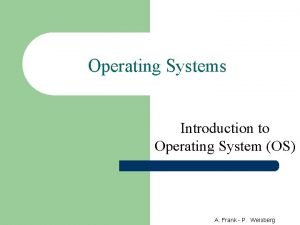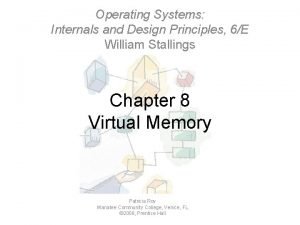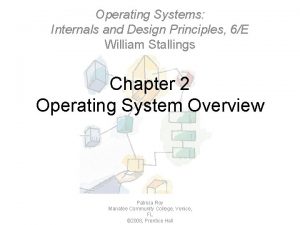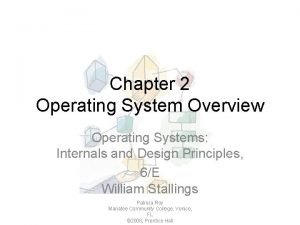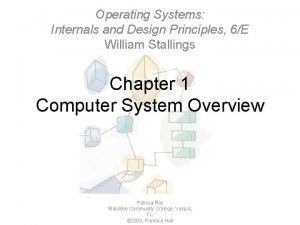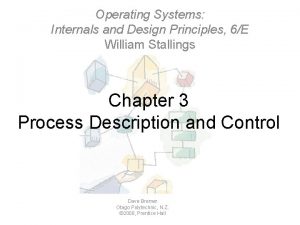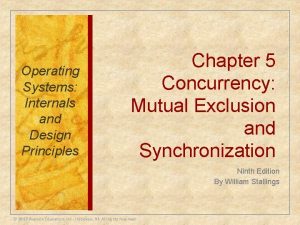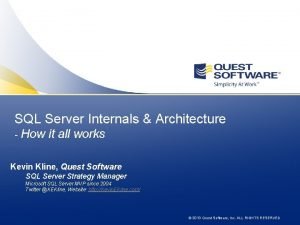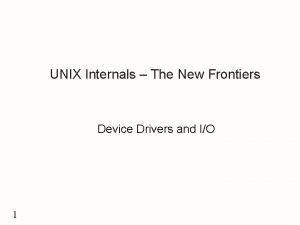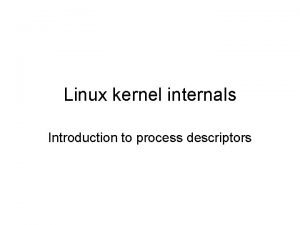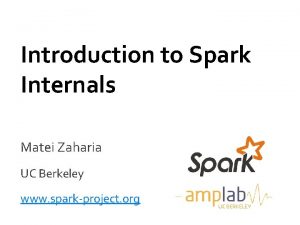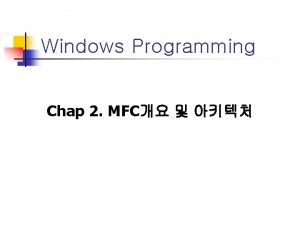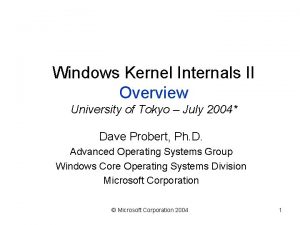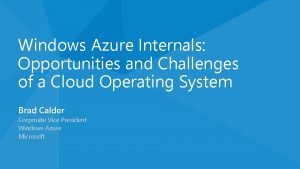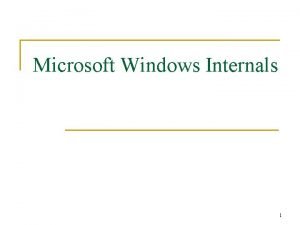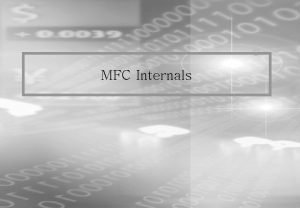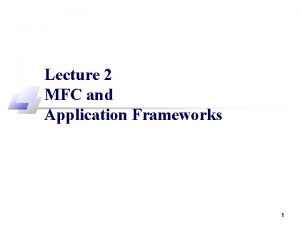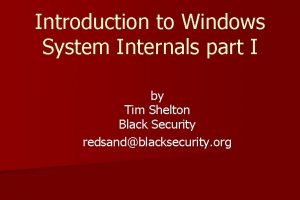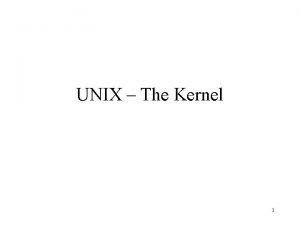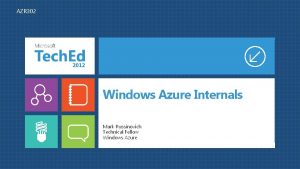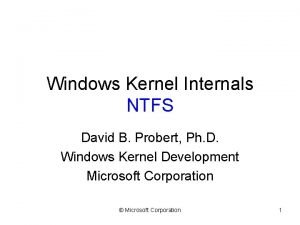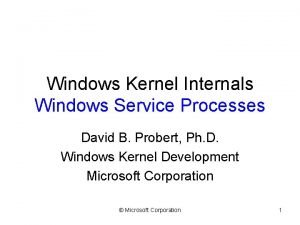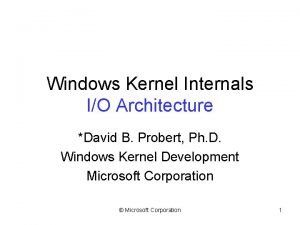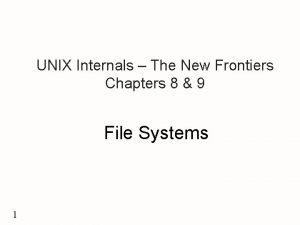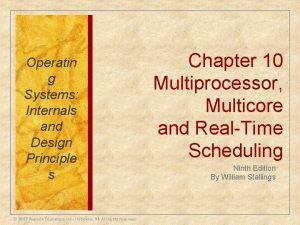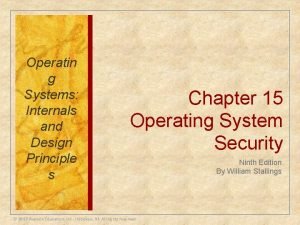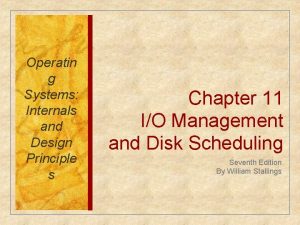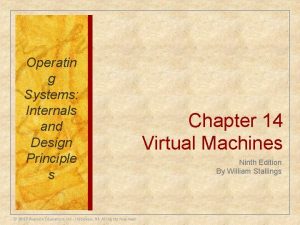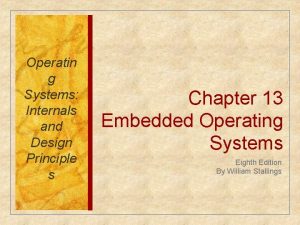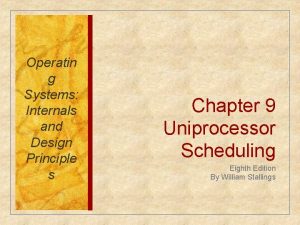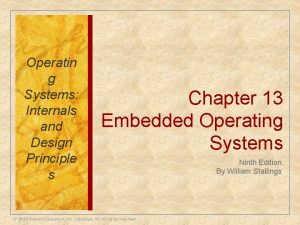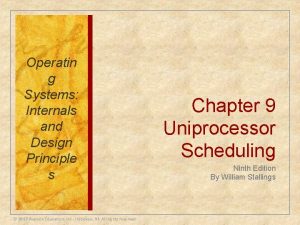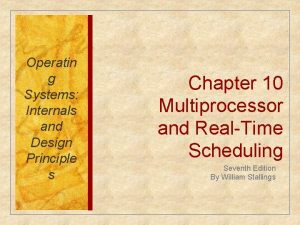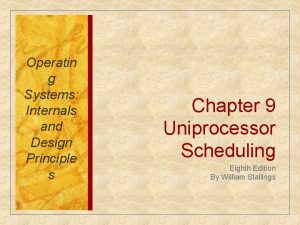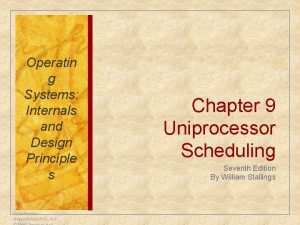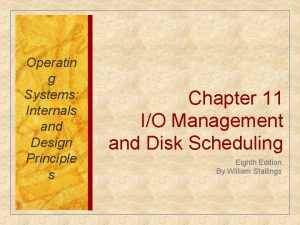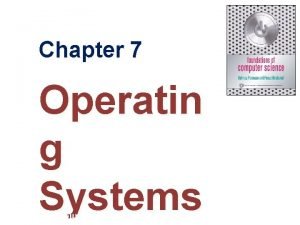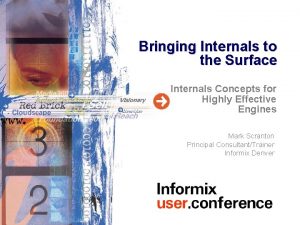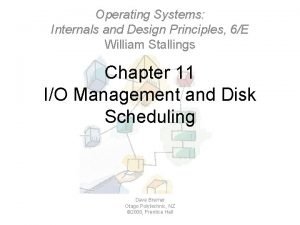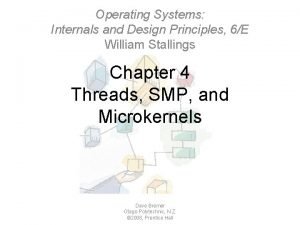Operatin g Systems Internals and Design Principle s














































- Slides: 46

Operatin g Systems: Internals and Design Principle s Dave Bremer Otago Polytechnic, N. Z. Chapter 9 Uniprocessor Scheduling Seventh Edition By William Stallings

Operating Systems: Internals and Design Principles “I take a two hour nap, from one o’clock to four. ” — Yogi Berra

Processor Scheduling n Aim is to assign processes to be executed by the processor in a way that meets system objectives, such as response time, throughput, and processor efficiency n Broken down into three separate functions: long term scheduling medium term schedulin g short term scheduling


Scheduling and Process State Transitions

Figure 9. 2 Nesting of Scheduling Functions (Referencing figure 3. 9 b)

Q u e u i n g i a g r a m

Long-Term Scheduler n n Determines which programs are admitted to the system for processing Controls the degree of multiprogramming n the more processes that are created, the smaller the percentage of time that each process can be executed n may limit to provide satisfactory service to the current set of processes Creates processes from the queue when it can, but must decide: when the operating system can take on one or more additional processes which jobs to accept and turn into processes first come, first served priority, expected execution time, I/O requirements

Medium-Term Scheduling n Part of the swapping function n Swapping-in decisions are based on the need to manage the degree of multiprogramming n considers the memory requirements of the swapped-out processes

Short-Term Scheduling n Known as the dispatcher n Executes most frequently n Makes the fine-grained decision of which process to execute next n Invoked when an event occurs that may lead to the blocking of the current process or that may provide an opportunity to preempt a currently running process in favor of another Examples: • • Clock interrupts I/O interrupts Operating system calls Signals (e. g. , semaphores)

Short Term Scheduling Criteria n n Main objective is to allocate processor time to optimize certain aspects of system behavior A set of criteria is needed to evaluate the scheduling policy User-oriented criteria • relate to the behavior of the system as perceived by the individual user or process (such as response time in an interactive system) • important on virtually all systems System-oriented criteria • focus in on effective and efficient utilization of the processor (rate at which processes are completed) • generally of minor importance on singleuser systems

Short-Term Scheduling Criteria: Performance examples: example: • response time • throughput Performance-related quantitative • predictability Criteria can be classified into: easily measured Non-performance related qualitative hard to measure

Table 9. 2 Scheduling Criteria

Priority Queuing

Alternative Scheduling Policies

n Determines which process, among ready processes, is selected next for execution n May be based on priority, resource requirements, or the execution characteristics of the process n If based on execution characteristics then important quantities are: § w = time spent in system so far, waiting § e = time spent in execution so far § s = total service time required by the process, including e; generally, this quantity must be estimated or supplied by the user

§ Specifies the instants in time at which the selection function is exercised § Two categories: § Nonpreemptive § Preemptive

Nonpreemptive n once a process is in the running state, it will continue until it terminates or blocks itself for I/O Preemptive n currently running process may be interrupted and moved to ready state by the OS n preemption may occur when new process arrives, on an interrupt, or periodically

Table 9. 4 Process Scheduling

Table 9. 5 Comparison of Scheduling Policies

n Simplest scheduling policy n Also known as first-in-first-out (FIFO) or a strict queuing scheme n When the current process ceases to execute, the longest process in the Ready queue is selected n Performs much better for long processes than short ones n Tends to favor processorbound processes over I/Obound processes

n Uses preemption based on a clock n Also known as time slicing because each process is given a slice of time before being preempted n Principal design issue is the length of the time quantum, or slice, to be used n Particularly effective in a general-purpose time-sharing system or transaction processing system n One drawback is its relative treatment of processor-bound and I/O-bound processes

Figure 9. 6 a Effect of Size of Preemption Time Quantum

Figure 9. 6 b Effect of Size of Preemption Time Quantum

Virtual Round Robin (VRR)

n Nonpreemptive policy in which the process with the shortest expected processing time is selected next n A short process will jump to the head of the queue n Possibility of starvation for longer processes n One difficulty is the need to know, or at least estimate, the required processing time of each process n If the programmer’s estimate is substantially under the actual running time, the system may abort the job

Exponential Smoothing Coefficients

Use Of Exponential Averaging

Use Of Exponential Averaging

n Preemptive version of SPN n Scheduler always chooses the process that has the shortest expected remaining processing time n Risk of starvation of longer processes n Should give superior turnaround time performance to SPN because a short job is given immediate preference to a running longer job

n Chooses next process with the greatest ratio n Attractive because it accounts for the age of the process n While shorter jobs are favored, aging without service increases the ratio so that a longer process will eventually get past competing shorter jobs

Feedback Schedulin g

Feedback Performance

Performance Comparison n Any scheduling discipline that chooses the next item to be served independent of service time obeys the relationship:

Table 9. 6 Formulas for Single. Server Queues with Two Priority Categorie s

Overall Normalized Response Time

Normalized Response Time for Shorter Processes

Normalized Response Time for Longer Processes

Results Simulation

Fair-Share Scheduling n Scheduling decisions based on the process sets n Each user is assigned a share of the processor n Objective is to monitor usage to give fewer resources to users who have had more than their fair share and more to those who have had less than their fair share

Fair-Share Scheduler

Traditional UNIX Scheduling n Used in both SVR 3 and 4. 3 BSD UNIX n these systems are primarily targeted at the time-sharing interactive environment n Designed to provide good response time for interactive users while ensuring that low-priority background jobs do not starve n Employs multilevel feedback using round robin within each of the priority queues n Makes use of one-second preemption n Priority is based on process type and execution history

Scheduling Formula

Bands n n Used to optimize access to block devices and to allow the operating system to respond quickly to system calls In decreasing order of priority, the bands are: Swapper Block I/O device control File manipulation Character I/O device control User processes

Example of Traditional UNIX Process Scheduling

n The operating system must make three types of scheduling decisions with respect to the execution of processes: n Long-term – determines when new processes are admitted to the system n Medium-term – part of the swapping function and determines when a program is brought into main memory so that it may be executed n Short-term – determines which ready process will be executed next by the processor n From a user’s point of view, response time is generally the most important characteristic of a system; from a system point of view, throughput or processor utilization is important n Algorithms: n FCFS, Round Robin, SPN, SRT, HRRN, Feedback
 Operating system internals and design principles
Operating system internals and design principles Slidetodoc.com
Slidetodoc.com Operating systems: internals and design principles
Operating systems: internals and design principles Operating systems: internals and design principles
Operating systems: internals and design principles Operating systems: internals and design principles
Operating systems: internals and design principles Operating systems internals and design principles
Operating systems internals and design principles Operating systems internals and design principles
Operating systems internals and design principles Operating system internals and design principles
Operating system internals and design principles Sql server internals and architecture
Sql server internals and architecture Zfs internals
Zfs internals Unix internals
Unix internals Linux kernel internals
Linux kernel internals Jvm internals
Jvm internals Spark internals
Spark internals Mfc internals
Mfc internals Ntos kernel
Ntos kernel Azure internals
Azure internals Windows internals
Windows internals Mapstruct cannot find implementation for
Mapstruct cannot find implementation for Mfc 프로그래밍
Mfc 프로그래밍 Advapi logon process
Advapi logon process Windows kernel internals
Windows kernel internals Unix internals
Unix internals Azure internals
Azure internals Android internals
Android internals B.ntns
B.ntns Windows kernel internals
Windows kernel internals Windows kernel internals
Windows kernel internals Ndis.sys latency
Ndis.sys latency Unix internals
Unix internals Decision support systems and intelligent systems
Decision support systems and intelligent systems Systems analysis and design kendall
Systems analysis and design kendall Dicapine
Dicapine Embedded systems vs cyber physical systems
Embedded systems vs cyber physical systems Engineering elegant systems: theory of systems engineering
Engineering elegant systems: theory of systems engineering Systems analysis & design in an age of options
Systems analysis & design in an age of options Systems analysis and design in a changing world
Systems analysis and design in a changing world Systems analysis and design in a changing world
Systems analysis and design in a changing world System analysis and design in a changing world
System analysis and design in a changing world Systems analysis and design dennis
Systems analysis and design dennis System analysis and design
System analysis and design Output design
Output design Ssadm tools
Ssadm tools Case tools are limited to systems analysis.
Case tools are limited to systems analysis. Modern systems analysis and design
Modern systems analysis and design Digital systems testing and testable design
Digital systems testing and testable design Design and redesign of work systems
Design and redesign of work systems

